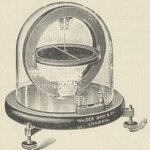Applied Physics

Saturday morning breakfast cereal just ran an excellent commentary on interdisciplinary (ex-pat?) physicists.
This cartoon just kept popping into my mind as I read a recent paper on gradient sensing (i.e. the single cell version of "sniff sniff, the cake is that way"). The paper was studying amoebas (that's Dictyostelium discoideum to you) that normally spend their lives crawling around hunting bacteria. They move and hunt much like white blood cells do, but they're a lot easier to work with since, since they divide in half every few hours so you don't have to…
Time is relative, of course, but we still hate to be late for appointments. So there has always been research on making our keeping of time a little more accurate.
A new clock tied to the orbiting of a neutron around an atomic nucleus could have such unprecedented accuracy that it neither gains nor loses 1/20th of a second in 14 billion years - basically, you wouldn't have needed to reset your watch yet even if you had been around at the beginning of the Universe.
Atomic clocks are already in use for GPS navigation systems and applications like system synchronization in particle…

The elusive antihydrogen atom has been manipulated using microwaves, providing the first glimpse of an "anti-atomic fingerprint."
Antimatter is a staple of science fiction, but it also stands out as one of the biggest mysteries of science fact. Fundamental theories predict perfect symmetry between matter and antimatter, but the glaring absence of antimatter in our universe suggests there might be a difference. Enter microwave spectroscopy, one of the most sensitive techniques for probing the structure of atoms.
"This study demonstrates the feasibility of applying microwave spectroscopy…

Last month, we were treated to the biggest solar storm since 2005, generating some of the most dazzling northern lights in recent memory. The source of that storm, and others like it, was the sun's magnetic field, described by invisible field lines that protrude from and loop back into the burning ball of gas. Sometimes these field lines break—snapping like a rubber band pulled too tight—and join with other nearby lines, releasing energy that can then launch bursts of plasma known as solar flares. Huge chunks of plasma from the sun's surface can hurtle toward Earth and damage orbiting…

In time for Valentine's Day, researchers have determined which champagne glass size will give drinkers the optimal experience.
A new study highlights the effects that champagne glass shape and temperature can have on carbonation upon serving - and therefore the drinking experience. The researchers, led by Gerard Liger-Belair (GSMA), Guillaume Polidori (GRESPI) and Clara Cilindre (URVVC) of the University of Reims in France, studied the gaseous CO2 and volatile organic compounds like ethanol in the space above the champagne surface after it is poured into either a tall, narrow flute…

Scientists have developed a soap composed of iron rich salts dissolved in water that responds to a magnetic field when placed in solution. That's right, magnetic soap.
But there is a practical side. The generation of this property in a fully functional soap could calm concerns over the use of soaps in oil-spill clean ups and improve industrial cleaning products.Scientists have long been searching for a way to control surfactants (soaps) once they are in solution to increase their ability to dissolve oils in water and then remove them from a system. The team at the University of…

When Electricians Were Opticians
Up until the late 19th century there were very few practical applications of experimental findings concerning electricity. Today, an electric circuit consists of a source of voltage or current, some connecting wires and a load. The purpose of the wires or cables is to convey the electricity to the load. The load can be something as simple as an ordinary light bulb. In the times of the early experimenters there were no loads as such, many of the things which might constitute a load not then having been invented. A circuit in the…

The Genius Of Georg Ohm
Much of the genius of Georg Ohm is forgotten. He is remembered mostly as the scientist who defined the relationship between electrical resistance, electric force and electric current. Not only do writers generally ignore Georg Ohm's many other contributions to physics: they give an all-too-brief outline of Ohm's law and then move on. Thus they miss the opportunity to explain the simplicity of the physical reality and the elegance of the mathematics behind Ohm's Law.
Prior researchers had used only vague terms and inexact measurements for the way…

Ohm For Christmas
The ohm is the unit of electrical resistance. It is named in honor of the genius of Georg Ohm, who figured out that the flow of electricity in materials from a 'hot' source might just resemble the flow of heat from a hot source. Ever since we started measuring electrical resistance in ohms, electricians and engineers have been making up atrocious puns based on that term. I decided not to make an exception here.
Christmas is a time to be thinking about the wider implications of the laws of thermodynamics and the fact that the universe is made of stuff, that…

Scientists aren't sure what causes clogs in flowing macroscopic particles, like corn, coffee beans and coal chunks. But new experiments suggest that when particles undergo shear strain, they jam sooner than expected.
Shear strain is sort of like cupping sand between your hands, and then, without changing the width between them, moving one hand forward and the other hand backward. Not much sand flows between your hands with a force like this.
Many flows, including those of nuts, coffee and coal, inherently produce this type of movement among grains, but the design and engineering for…